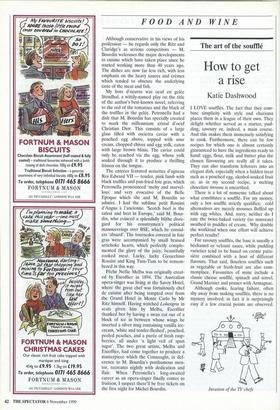The art of the soufflé
How to get a rise
Katie Dashwood
I LOVE souffles. The fact that they com- bine simplicity with style and charisma places them in a league of their own. They delight whether served as a starter, pud- ding, savoury or, indeed, a main course. And this makes them immensely satisfying to cook. Furthermore, there can be few recipes for which one is almost certainly guaranteed to have the ingredients ready to hand: eggs, flour, milk and butter plus the chosen flavouring are really all it takes. They can also transform leftovers into an elegant dish, especially when a hidden treat such as a poached egg, alcohol-soaked fruit or, as in my second recipe, a melting chocolate mousse is unearthed.
There is a lot of nonsense talked about what constitutes a soufflé. For my money, only a hot souffle strictly qualifies; cold alternatives are merely mousses fluffed up with egg whites. And, sorry, neither do I rate the twice-baked variety (so nouveau) swathed in puddles of cream. Why double the workload when one effort will achieve perfect results?
For savoury souffles, the base is usually a béchamel or veloute sauce, while pudding varieties tend to be based on crème patis- siere combined with a host of different flavours. That said, flourless souffles such as vegetable or fresh-fruit are also com- monplace. Favourites of mine include a classic cheese soufflé, spinach and sorrel, Grand Marnier and prunes with Armagnac.
Although cooks, fearing failure, often shy away from making souffles, there is no mystery involved; in fact it is surprisingly easy if a few crucial points are observed.
Invasion of the TV chefs
First, whatever its composition, the basic mixture should be soft enough to drop from a spoon: too thin and the egg whites will be difficult to fold in; too thick and the soufflé will never rise. Turning to the egg whites themselves, use those which are sev- eral days' old as they whisk better than newly-laid eggs. Purists may insist on a cop- per bowl and wire balloon-whisk but, since I am currently nursing a shattered elbow and hence am not in bicep-building mood, I shall happily settle for an aluminium bowl (glass and pottery bowls lose volume) and my electric beaters. The trick here is to ensure that both are scrupulously clean and grease-free. If in doubt rub a lemon slice around the interior of the bowl, then dry thoroughly.
Generally speaking, about one-third more whites than yolks is the correct pro- portion. Once whisked, it is vital for the success of a sweet souffle to meringue the whites with a spoonful of sugar per four whites and beat until glossy; for savoury versions add a pinch of salt or cream of tar- tar. Always fold them with a metal spoon into the mixture (while it is still hot), employing a lifting action to incorporate as much air as possible; the heat of the mix- ture will cook the whites so that they become firm. Meanwhile, prepare the dish or individual ramekins by buttering the inside and coating with either grated Parmesan, breadcrumbs or sugar. Forget the paraphernalia of paper collars; if a souffle is going to rise, it will do so in any case. Remember also that certain edible foods make ideal receptacles, e.g., crisp baked-potato skins, large tomatoes and, above all, globe artichoke shells from which the leaves can be pulled off and dipped into an ultra gooey cheese mix (try Gruyere).
A useful tip taught me by the French chef Christian Germain, of Château de Montreuil fame, is to 'layer' the ingredi- ents into the dish to help it rise, i.e., if making a smoked haddock soufflé, incor- porate only half the flaked fish into the mix, setting aside the rest. Then spoon some of the mixture into the dish, followed by a modest covering of the reserved had- dock and repeat the process until full. Always take care that no drips hit the edges as this disrupts the rising action. Smooth the surface gently before running a (clean!) thumb around the rim to dispose of surplus mixture and prompt an even rise. Once assembled, souffles can stand for several hours in the fridge before being cooked — a life-saver for those wishing to entertain and impress.
The correct oven temperature is a sub- ject of much discussion and yet, provided the mixture is right, I think it is largely irrelevant. Some experts recommend start- ing with a high heat and then reducing it;
the French cook their souffles fast. Mine usually come up trumps within the confines of my Aga even if, on occasion, a little patience needs to be exercised before there is any sign of upward ascent. Contrary to popular belief, souffles are fairly resilient and can withstand the oven door being opened, though not to a gale-force draught. When done, a souffle should be brown on top with a softish crust and a runny, almost sauce-like centre, providing a pleasing con- trast in textures. It should not deflate instantly but needs rapid transport to the table.'A charmingly old-fashioned touch is to heat through two silver serving-spoons, wrapping the handles in linen napkins. An authentic souffle does not require much extra embellishment and I am not a fan of sauces being poured into an opening at the top, however spectacular the effect. Some- how it's a bit theatrical — rather more West End than Wandsworth. If, for what- ever reason, your effort does not scale the heights you had prayed it might, then so what? I'm willing to bet that it will still taste delicious. Simply shrug nonchalantly, smile sweetly and explain: 'Pardon, mais it ne souffle pas.'
Cheese soufflé (serves four)
butter for greasing 250g mature Cheddar cheese (try a combina- tion including Lincolnshire Poacher), finely grated 5 large eggs 60g butter 60g plain flour 280 ml milk, heated seasoning generous pinch of freshly grated nutmeg teaspoonful of English mustard 2 heaped tablespoons of grated Parmesan cheese
Butter the interior of a 1.45-litre (2-pint) soufflé dish and dust with half the Parme- san. Melt the butter in a large saucepan. Mix in the flour to form a smooth roux and cook for one minute. Remove from the heat and whisk in the milk until thick and smooth. Allow to cool slightly and then add 3 to 4 egg yolks and beat in thoroughly. Stir in the mustard, nutmeg and half the Ched- dar cheese, then season. In a separate bowl beat the whites of five eggs until stiff but not thy, adding a pinch of salt. Using a metal spoon, carefully fold a quarter of the whites into the warm mixture, then gently incorporate the remainder. Turn one-third of the mixture into the prepared dish, fol- lowed by one-third of the reserved cheese, and continue the process until all the ingrE- dients are used. Sprinkle the surface with the remaining Parmesan and place in the oven at 180°C and cook for approximately 25-30 minutes or until the souffle is well risen, golden and slightly wobbly in the centre. Serve with mustard. Cointreau and chocolate souffle (serves 8)
For the chocolate mousse: 150g plain unsweetened quality chocolate 1 egg and 1 egg yolk 65g caster sugar 175g double cream, whipped to soft peaks For the soufflé: 210m1 milk 3 egg yolks 65g caster sugar 30g plain flour 1 vanilla pod Grand Marnier to taste 8 egg whites grated zest of an orange
Prepare individual ramekins by painting the insides with melted unsalted butter then coat with caster sugar. To make the mousse, melt chocolate in a bain-marie. In a bowl beat together the egg plus the extra yolk with the sugar to a ribbon-like consistency. Once the chocolate has melted, add to the egg and sugar mixture then incorporate the cream. Divide the chocolate mixture between the ramekins (to fill approximately one-third of each) and freeze until ready to cook with the soufflé on top.
For the crème patissiere, heat the milk, vanilla pod and a small amount of sugar together in a pan. In a separate bowl, mix the flour, the rest of the sugar and the egg yolks. When the milk boils, pour on to the flour etc. and return everything to the pan and cook through over a medium heat for 2-3 minutes then remove pod. Whisk in the Grand Marnier and grated orange zest, then set aside in a warm place (cover the surface with a layer of clingfilm to prevent a skin forming). In a clean bowl whisk the egg whites with a little sugar until firm and glossy, then fold into the creme patissiere. Fill the ramekins, levelling off the tops. Place in a roasting tin half filled with boil- ing water and cook in a hot oven at 200°C for 10-12 minutes. Dust each one with sieved icing sugar and serve immediately.




























































































 Previous page
Previous page